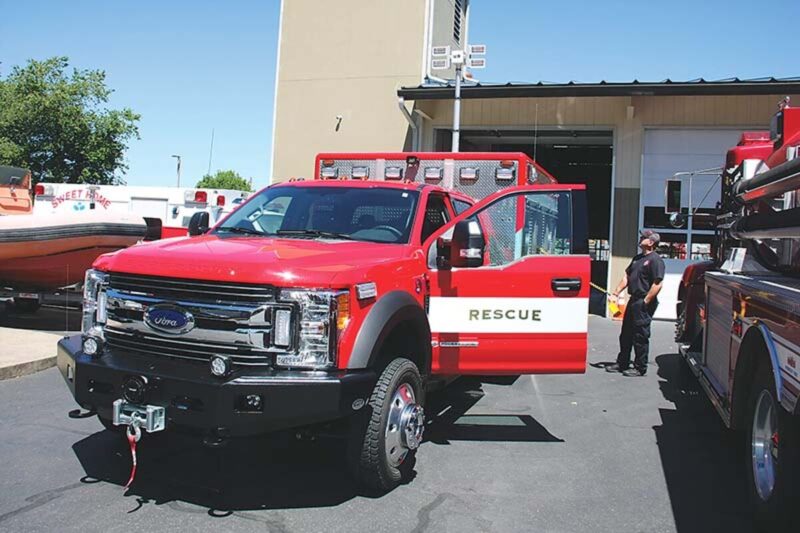Sean C. Morgan
The Sweet Home Fire and Ambulance District recently replaced one of its two rescue units and took delivery of a new four-wheel drive fire engine for use on and off pavement.
The district purchased the urban interface engine from San Diego County, Calif., for $120,000 using bond funds that will be repaid through the district’s equipment reserve fund with funding originating from reimbursements the department has received for responding to conflagrations in California and Oregon.
The district also is paying approximately $120,000 to $130,000. The vehicle is among numerous equipment and construction projects funded by the six-year $1.575 million bond levy approved by voters in 2016.
The total cost isn’t set on the rescue unit yet, said Fire Chief Dave Barringer. The district is still considering some equipment options.
The rescue unit, Rescue 25, takes advantage of a rescue box donated by the Mohawk Valley Fire District. The box was mounted on a $52,000 chassis. It features an LED light tower.
“You want to talk about bang for your buck,” Barringer said, noting that, new, the unit would have cost $75,000 to $80,000 more.
The rig replaces a 1993 Ford with a smaller box that didn’t work as well as the new box, Barringer said. The old rig was overweight for its brakes, and alternator couldn’t handle the unit’s electrical load.
This one is set up to haul rescue equipment better, Barringer said, noting that the old unit was a product of its times but had become obsolete.
“In 1993, it was a great deal,” Barringer said. The new rig is capable of handling the current weight of proper rescue gear. “There’s an obvious difference in the technological advances that have been made.”
The LED lights, he said, are “set up to light a scene appropriately for what you’re doing.”
“It’s a four-wheel drive,” said Battalion Chief Eli Harris, who heads up the district’s rescue program. The old unit “was so old it was almost dangerous to drive.”
The unit has a repeater installed in it, so any rescuer who is able to reach the vehicle by radio can talk to dispatch or a helicopter, he said. “If it can hit this, it can get out.”
The rescue gear storage is better too, Harris said. Trays carrying equipment can be pulled all the way through the box to either side of the vehicle.
Water rescue equipment has a separate storage area, which keeps dry rescue gear from getting wet and growing mildew, he said. The storage is all easier to access, making it easier for rescuers to see and grab the right piece of equipment.
The new unit carries a 30-gallon compressed air foam fire suppression system, he said. Because the air is compressed, the vehicle doesn’t have to be running.
“If you’re going to do (vehicle) extraction), you have to be able to fight fire,” Harris said. The district used to have to dispatch an engine before it could fight fire in a vehicle.
That’s slow going to the east up Highway 20 during the winter, he said.
The light tower is a big deal, he said. The old unit didn’t have its own light tower, and Rescue 21 is too big to get into some spaces. The tower provides on-scene safety and allows rescuers to see what they’re doing.
Rescue 25 has already responded to five calls all in remote locations around Tamalich Falls, Blue Pool and up Quartzville. Two involved bicycles, and one involved walking. In another, rescuers had to use rope to reach a 76-year-old woman who had fallen. She was transported to the hospital by air ambulance.
Rescue 21, the orange engine, remains in service as a heavy rescue unit, Barringer said. It’s getting new roll-up doors to replace swinging doors that sometimes fall open and can get in the way on scene.
Firefighters and rescue technicians cannot see traffic around the existing doors, Barringer said.
District staff members are debating whether it should remain a rescue unit, Barringer said. The urban interface engine may make more sense with its four-wheel drive, allowing it to go more places.
The new engine will also handle wildland fires outside the district, the conflagrations in Oregon and California.
The district sent Engine 22 to California last year, Barringer said, but it’s designed for pavement. The engine held up, but pavement engines from other departments took a beating working off-road. The four-wheel drive and higher clearance make the new engine a better choice off pavement for assisting on wildland fires.
“It’s built for wildland,” Harris said.
It also helps out in Sweet Home, Barringer said. While current regulations limit the slopes of rural driveways, many pre-existing driveways are steeper. The engine can negotiate those driveways better – “you live on Marks Ridge and you have a steep driveway, we may get there.”
The district is currently applying for a conditional use permit from the city to remodel the Foster Fire Station, another bond project.
“We’ve got to get bids as soon as the conditional use permit comes out,” Barringer said. The board must accept a bid, and then the district can get to work.
Talking to contractors, Barringer thinks the project won’t start until October or November; and with so much demand for builders he is hoping bids come in at less than $200,000. The district initially estimated the cost of the project at $100,000.
The project will add a new bay door, allowing the district to easily park three pieces of apparatus in the station. It also adds a second-floor living space for up to three persons.





